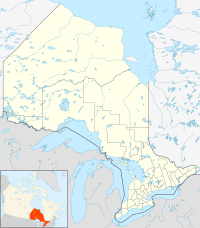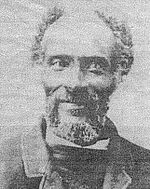Wilberforce Colony facts for kids
Quick facts for kids
Wilberforce Colony
|
|
|---|---|
| The Wilberforce Settlement | |
| Country | |
| Province | Ontario |
| County | Middlesex County, Ontario |
| Established | 1829 |
| Founded by | Israel Lewis and Thomas Crissup |
| Government | |
| • Type | Colony |
| Area | |
| • Total | .1.6 km2 (0.04 sq mi) |
| Population
(1835)
|
|
| • Total | 166 |
| • Density | 1,700/km2 (4,300/sq mi) |
| Time zone | UTC-5 (EST) |
| • Summer (DST) | UTC-4 (EDT) |
The Wilberforce Colony was a special community started in 1829. It was founded by free Black people in Canada, north of where London, Ontario is today. These families wanted to create a place where they could live with true political freedom.
Many Black communities in the United States wanted to move to a country where they could control their own future. The Wilberforce Colony was one such place. It was planned by Black Americans from Cincinnati, Ohio. They moved after unfair laws were passed in 1828 and a violent riot happened against them in 1829.
This new community grew quickly. Even people who had escaped slavery and found freedom in Canada joined the colony. However, problems like disagreements, not enough money, and the chance of jobs in bigger cities caused it to shrink by 1850. In the 1840s, many Irish immigrants settled in the area, fleeing a terrible famine in their homeland. The Wilberforce Colony lasted as an independent Black community for less than 20 years.
Contents
Why the Colony Started
Cincinnati's Black population grew a lot in the 1820s. Even though Ohio was a free state, parts of it were influenced by people from the South. This led to more racial tension. In 1820, Black people made up less than 4% of Cincinnati's population. But over the next ten years, their numbers grew by over 400%.
This fast growth worried some White residents. In 1828, the Cincinnati City Council formed a committee to stop the increase of Black people in the city. In March of that year, the Ohio Supreme Court said that the 1807 state Black Laws were legal. These laws put many limits on Black people's lives and jobs. The Cincinnati City Council then started to enforce these strict laws.
Buying Land in Canada
In June 1828, the Black community in Cincinnati chose Israel Lewis and Thomas Crissup. Their job was to find a place in Canada where they could move. Lewis and Crissup met with John Colbourne, who was the Lieutenant Governor of Upper Canada. They talked about the idea of settling there.
They made a deal with the Canada Company to buy land in Biddulph, in the Huron Tract of Ontario. The land was near the Ausable River. It was about 32 kilometers from Lake Huron and 56 kilometers from Lake Erie. They agreed to buy 4,000 acres for $6,000. This money was supposed to be paid by November 1830.
Moving from Cincinnati
The Cincinnati riots of 1829 started in early July and lasted until the end of August. White people attacked Black people, forcing about 1,000 Black individuals to leave Cincinnati.
Those who left that summer formed two groups. One group was forced out by violence and fear. They usually settled in nearby towns in the United States. The second group planned a longer journey. Many traveled nearly 640 kilometers to the Canadian site. However, settling in the Wilberforce Colony meant buying land. So, those without money stopped in the U.S. They settled in towns near Lake Erie where they could find work. They never reached Canada.
Those who made it to Canada had to travel about 56 kilometers north from Lake Erie. This journey was through thick, wild forest. Once they arrived, they had to clear land for crops and build homes. We don't know exact numbers, but it seems only five or six families reached the Ontario colony in the first year.
Settling and Naming the Colony
The first agreement between the Canada Company and Lewis and Crissup required a $6,000 payment by November 1830. But they didn't have enough colonists right away to help pay for the land. The first colonists also didn't have enough money to cover the cost. So, the colony's finances were very shaky during that first year.
They asked others for help. They tried to raise money in Cincinnati and asked the Ohio state legislature, but they didn't get any help. However, they had success when they asked the Quakers, many of whom were in Oberlin, Ohio. On September 20, 1830, James Brown and Stephen Duncan bought 400 acres for the settlement.
With the land secured, the colonists began clearing the land and building homes. In 1831, the settlement was named "Wilberforce." This name honored William Wilberforce, a famous British person who worked to end slavery. He fought against the British slave trade and helped pass a law in 1807 that stopped the slave trade across the British Empire. Slavery itself was not ended in the British Empire until 1833, becoming effective in 1834.
How the Colony Grew
The first people who moved to Wilberforce were often educated Black individuals from Cincinnati. Education for their children was very important to them. They continued a tradition from Cincinnati, where the community valued learning greatly. The first building in Wilberforce was a school.
In 1831, an American social reformer named William Lloyd Garrison visited the colony. He saw that 20-30 children were going to school. By 1832, they had set up three schools. These schools were so good that even children from the surrounding White population came to learn there. The colonists wanted more than just basic reading and writing.
By 1832, the settlement also had crops growing and log homes built. Settlers built three sawmills, which cut wood. They also built a gristmill, which ground grain into flour, and several general stores. The colony was close to the Ausable River. This made it easy to transport goods and to send out products like crops and wood.
The riots in Cincinnati and the start of Wilberforce Colony helped Black people across the country become more aware of their shared struggles. More people in other northern cities became interested in moving. The Mother Bethel A.M.E. Church in Philadelphia brought together Black leaders from across the North. They wanted to find ways to empower all African Americans.
In 1830, at a national meeting, they formed the American Society of Free Persons of Color (ASFPC). This was the start of the Black convention movement. At their first yearly meeting, the ASFPC suggested building a college for young men in New Haven, Connecticut. When this idea didn't work out, they looked to Wilberforce. They tried to raise money across the United States and Great Britain, led by Nathaniel Paul. This fundraising effort failed, but it showed how important higher education was to the Wilberforce colonists.
Within the first 18 months, Wilberforce grew from just a few families. Other Black American immigrants joined them from Boston, Rochester, Albany, New York, Baltimore, and other cities. Later efforts to attract more people brought Black families from other northern cities. By 1832, there were 32 families in the area. By 1835, the community had 166 people. Eventually, about 150-200 families settled there.
With more African Americans arriving from different cities, the colony started to develop politically. A board of managers was created, mainly to handle money matters. Austin Steward, an abolitionist who had recently arrived from Rochester, New York, was named president. He and other new people replaced the original leaders from Cincinnati. In 1831, Israel Lewis, who had first organized the colony and bought the land, became a fundraising agent in the U.S. Nathaniel Paul was the other fundraising agent, working in England.
Decline and End of the Colony
Disagreements between the first Cincinnati families and the new settlers eventually led to the colony's decline. The Cincinnati leaders were used to city life and found it hard to adapt to the tough farming environment. Within the first ten years, many of the leaders who had moved to Wilberforce left the community.
Also, both fundraising agents did not meet expectations. By 1839, suspicions of dishonest actions, especially by Lewis, made the colony's problems worse. A historian of the area wrote:
Nathaniel Paul, who went to England to ask for money, came back with over $7000. But his expenses were over $8000, leaving the Colony with a large debt. The actions of the second agent, Israel Lewis, caused even more harm. Lewis spent over 10 years collecting money across the United States and Canada. But he stubbornly refused to give any money to the Board of Managers. Angry and upset, the Board of Managers had to put warnings in several newspapers telling people not to give money to Lewis. The bad news that came out seriously hurt the Colony's reputation. Long-time supporters, including abolitionists and the Quakers of Ohio and Indiana, started to stop their help.
By the late 1840s, Irish immigrants began moving into the area. They were part of a large wave of people fleeing a widespread famine in Ireland. The Black population in Wilberforce greatly decreased. Many of the original colonists moved to bigger cities like Detroit, Cleveland, or Toronto. They went there to find jobs that paid wages. Eventually, the Irish community took over the area completely. The town of Lucan was then officially formed. Wilberforce, as a free Black colony, became a part of history.
A small number of Black families stayed to work the land for many generations. But by the end of the 1900s, only the family of settler Peter Butler still had descendants living in the area of the Wilberforce Colony village.
Important Dates
1828
- June — Black people in Cincinnati choose Israel Lewis and Thomas Crissup to find a place in Canada to move to.
- July — Lewis and Crissup meet with John Colbourne, the Lieutenant Governor of Upper Canada. They discuss settling there and make a deal with the Canada Company to buy land in Biddulph, Ontario.
1829
- July–August — The Cincinnati riots force over 1,000 African Americans to leave the city. A group of these people head for the new settlement.
- September — The first group of settlers, likely only five or six families, arrive in the area.
1830
- September 20 — James Brown and Stephen Duncan buy 400 acres of land to help establish the colony.
1831
- The settlement is named "Wilberforce" to honor William Wilberforce.
- People from Boston, Rochester, Albany, New York, Baltimore, and other cities join the settlement.
- William Lloyd Garrison visits the colony and notes that 20-30 children attend schools.
- A board of managers is created, with Austin Steward named president.
- Israel Lewis becomes the local fundraising agent, and Nathaniel Paul is named the fundraising agent for Great Britain.
1832
- Wilberforce has 32 families, with crops growing and log homes. The colony has three sawmills, a gristmill, and several general stores.
- Three schools are established, attracting students from the surrounding white population.
1835
- The population of Wilberforce reaches 166 people.
1836
- Lewis is accused of mismanaging the fundraising money.
1840
- Most of the original settlers from Cincinnati have left the colony.
1850
- The Black population in the area decreases due to Irish immigration. The colony effectively ends.



